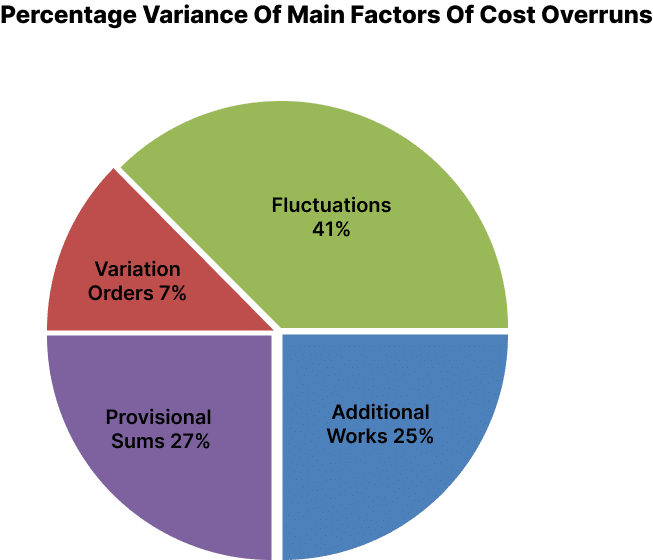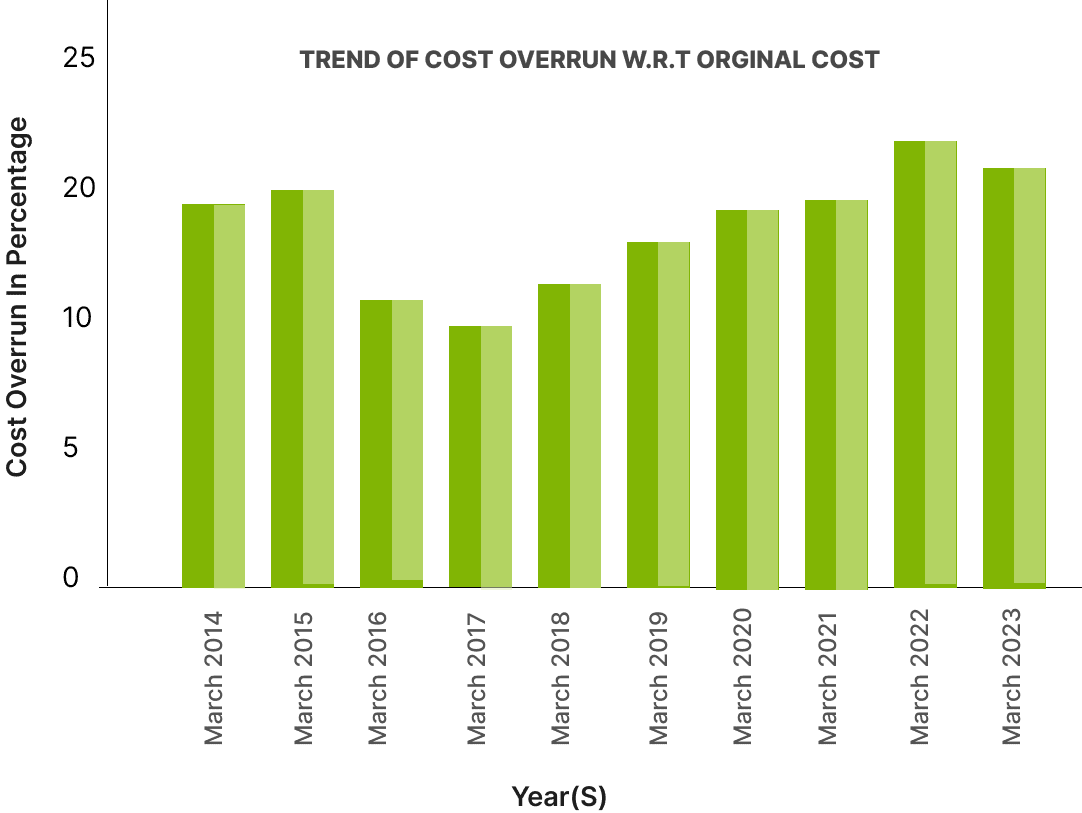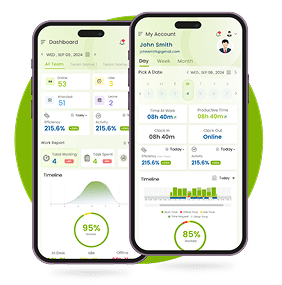In a global study of 1,471 IT projects, the average cost overrun was 27%, with 17% of projects experiencing cost overruns averaging 200%, threatening the viability of the companies involved. These staggering numbers highlight just how prevalent and devastating project cost overruns can be. Imagine a project you’ve been overseeing for months suddenly spirals out of control, with costs surging beyond your expectations, putting not only the project but also your company’s financial stability at risk.
This scenario is all too familiar for project managers across industries, especially in IT and technology, where complex systems, evolving requirements, and unforeseen challenges can lead to significant budgetary pressures. However, with the right tools, such as project tracking software, you can minimize these risks. Time tracking softwarehelps you monitor progress, manage budgets, and identify potential cost overruns early, allowing you to take corrective actions before the situation becomes critical.
In this blog, we will delve into the common causes behind project cost overruns, find how to better manage project budgets, and offer practical solutions and tools, like project time tracking software, to help you keep your projects within budget, avoiding the financial pitfalls that could threaten your company’s success. Whether you’re handling software development, infrastructure, or other types of projects, understanding and managing project budget overruns is critical for long-term success.
What Are Project Cost Overruns?
A project cost overrun occurs when a project exceeds its original budget due to various internal or external factors. This can happen in any industry, from construction to software development, and can significantly impact both project outcomes and business operations.
and can significantly impact both project outcomes and business operations. A study by the Standish Group in 2004 found that the average cost overrun for IT projects was 43%, with 71% of projects exceeding their budgets, timelines, or scope estimates. In the construction sector, numerous projects have experienced significant cost overruns. For example, the Sydney Opera House project in Australia was completed ten years later than planned, with costs escalating from an initial estimate of $7 million to $102 million.
The causes of cost overruns are multifaceted. They often include scope changes,inadequate planning,unforeseen challenges, and communication failures among stakeholders. A significant 33% of project failures are linked to poor communication, underlining the importance of maintaining clear and consistent dialogue among all parties involved. This is where project billing tools and project invoice & billing solutions can ensure transparency and proper tracking of expenses throughout the project.
Mitigating cost overruns requires a multifaceted approach. Enhanced planning, including thorough feasibility studies and accurate cost estimates, can prevent unforeseen expenses. Establishing regular and transparent communication among stakeholders ensures alignment and facilitates timely issue resolution. Using technology can also play a crucial role; 61% of project managers report that technological tools help reduce errors and control costs.
Addressing these challenges is crucial for organizations aiming to maintain profitability and achieve successful project outcomes.
Like this; inaccurate project cost estimates can lead to significant financial implications for clients. Insufficient feasibility studies and incomplete pricing of all work items in the Bills of Quantities (BOQ) before project commencement often result in actual costs exceeding initial estimates. These discrepancies, typically higher than provisional sums allocated in the BOQ, contribute to substantial cost overruns.

Top 6 Causes of Cost Overruns
1. Poor Scope Management
During a software project, the initial scope was to create a basic accounting tool. However, halfway through, the client demanded additional features like payroll processing and invoicing functions that weren’t part of the original agreement. The development team struggled to manage these new requirements, and without proper re-estimation, the project’s budget ballooned as extra resources were required to implement the new features.
Poor scope management is one of the leading causes of project cost overruns. When the scope isn’t clearly defined or changes happen without adequate planning, projects often experience delays, added costs, and resource strain.
2. Inaccurate Estimates
In a construction project, the budget initially accounted for $500,000 worth of materials based on a rough estimate. However, the actual material costs ended up being 30% higher than projected due to inflation in raw materials and unforeseen price hikes. The project had to reallocate funds to cover the shortfall, resulting in an overrun.
Inaccurate estimates, whether in time, cost, or resources, can result in significant overruns. Estimation mistakes can occur due to lack of data, unrealistic assumptions, or unforeseen market fluctuations, leading to project budget issues.
3. Unforeseen Risks
During the early stages of the construction of a large factory, the COVID-19 pandemic hit. Supply chains were disrupted, labor availability decreased, and new safety protocols had to be implemented. These unexpected challenges pushed the project back by months and added costs to ensure health and safety compliance.
Unforeseen risks, such as natural disasters, pandemics, or even regulatory changes, can wreak havoc on project budgets. When these risks aren’t properly anticipated or planned for, they can become major drivers of cost overruns.
4. Communication Gaps
A marketing firm undertook a project to rebrand a client’s website. However, communication breakdowns between the design and development teams led to duplicated efforts, misaligned deliverables, and rework. The final product was delivered late and over budget as a result of these miscommunications.
Poor communication between project stakeholders is a common cause of budget overrun. Misunderstandings, unclear expectations, and the lack of regular updates can cause costly delays, rework, and missed deadlines, all of which affect project budget management.
5. Resource Mismanagement
A construction firm began a high-rise project with an over-allocated workforce, believing more workers would speed up the process. However, the additional labor resulted in inefficiencies, poor coordination, and inflated labor costs. Ultimately, the project went over budget due to the mismanagement of human resources.
When resources, whether human, material, or equipment, are not properly allocated or managed, costs can skyrocket. Overstaffing or underutilizing resources can lead to inefficiencies and higher-than-expected expenses, putting the project budget at risk.
6. Technology Failures
A tech startup embarked on a new app development project. However, midway through development, the software development platform they were using encountered a major issue, causing frequent crashes. The technical team had to spend extra time fixing the bugs and reworking the code, which caused significant delays and increased costs.
Technology failures can cause severe disruptions in any project, especially those dependent on software or complex systems. When critical tools or infrastructure fail, projects often suffer from delays and increased costs, which negatively impacts project budget and cost management.
Did You Know?
Under PRAGATI, ananalysis of cost overruns reveals a rise from 19.4% in March 2014 to 21.92% in February 2023. The trend in cost overrun relative to the originally approved costs has steadily increased over the years, as shown in the following graph:

How to Calculate Cost Overrun
A cost overrun occurs when the actual cost of a project exceeds the budgeted cost. To calculate the cost overrun, you can use a simple formula:
Cost Overrun = Actual Cost – Budgeted Cost
Example:
Let’s say you’re working on a software development project. The original budget allocated for the project was $200,000. However, due to unforeseen challenges and scope changes, the actual cost of the project ended up being $250,000. Using the formula:
Cost Overrun = $250,000 (Actual Cost) – $200,000 (Budgeted Cost) Cost Overrun = $50,000So, the cost overrun for this project is $50,000, which means the project exceeded its budget by 25%.
Proven Strategies to Prevent Cost Overruns
Research indicates that a majority of large IT projects exceed their allocated budgets by over 45%. As these projects expand in scope and impact more areas of an organization, any missteps can pose significant risks to the company’s overall performance. With annual losses exceeding $66 billion due to cost overruns, losing control over project budgets can substantially erode a company’s profitability.

Managing Project Backlog and Task Prioritization
A well-managed project backlog is essential for preventing cost overruns. Regularly reviewing and prioritizing tasks ensures that critical activities are tackled first, avoiding delays and resource misallocation. By using project billing systems alongside task management, you gain better visibility into both financial and task progress, preventing backlog issues. Aligning task prioritization with project time tracking software ensures focus on high-value deliverables, reducing time cost and improving efficiency.

Detailed Planning and Budgeting
The foundation of a successful project starts with clear and well-defined planning. To prevent cost overruns, it is crucial to ensure that the project scope is clearly defined and documented from the outset. Ambiguous or poorly defined scopes often lead to increases in costs due to changes in requirements as the project progresses. A realistic budget is also essential for managing expenses. This means developing a complete budget that covers all expected costs, including contingency reserves for unforeseen circumstances. Accurately estimating costs by relying on historical data, expert judgment, and industry benchmarks is also vital. Additionally, accounting for inflation and market price fluctuations ensures that the budget remains aligned with reality over time.

Regular Monitoring and Reporting
Once the project is underway, continuous tracking is key to staying within budget. Regular progress reviews should be conducted to assess whether the project is on track. Project management tools are invaluable in tracking spending, resource usage, and timelines, helping to detect any signs of cost overruns early. Variance analysis is another critical step, enabling the project manager to identify discrepancies between planned and actual costs. By addressing these issues early, you can avoid significant financial challenges later. Establishing clear Key Performance Indicators (KPIs) allows for the monitoring of progress and the identification of potential problems before they escalate into a budgetary crisis.

Project Billing and Cost Control
Accurate project billing is crucial for controlling costs. By using project invoice & billing tools project managers can track expenditures in real-time and make necessary adjustments before costs spiral. Integrating billing with time and task tracking systems enables better forecasting and keeps the project on budget. Detailed billing software provides clear visibility into resource allocation, helping teams optimize costs and improve financial alignment with the original budget.

Risk Management
Risk management is a crucial aspect of any project to control costs effectively. Identifying potential risks early on, such as material price increases, labor shortages, or unforeseen technical challenges, helps mitigate their impact on the budget. Developing risk mitigation plans, including contingency strategies and procurement plans, can protect the project against unexpected cost increases. Including contingency funds within the budget is also essential to ensure the project can absorb unforeseen costs without jeopardizing its success.

Effective Communication and Stakeholder Management
Maintaining transparent communication with all stakeholders is key to preventing misunderstandings that may lead to budget increases. Keeping stakeholders informed of project progress, issues, and any necessary changes helps align expectations and avoid surprises. A formal change management process should be implemented to handle any adjustments to the project scope or budget. Each change should be carefully evaluated for its impact before being approved, ensuring that any modification aligns with the overall goals of the project.

Contract and Vendor Management
When it comes to contracts and vendor relationships, clarity is essential to prevent cost overruns. Clearly defining contract terms with vendors and contractors, including payment schedules, deliverables, and penalties for delays or non-performance, can help keep costs under control. Building strong relationships with vendors ensures effective communication and timely delivery of goods and services. Where possible, negotiating fixed-price contracts can further limit cost uncertainty. Regular performance reviews of subcontractors are also necessary to ensure that they meet their deadlines and stay within budget, avoiding potential overruns in subcontracted areas.

Resource Optimization
Efficient resource allocation is a fundamental factor in keeping costs under control. Ensuring that labor, equipment, and materials are allocated appropriately helps prevent overstaffing or underutilization, both of which can drive up costs. Employee utilization plays a crucial role in this process, ensuring that the workforce is engaged at optimal levels without being overburdened or underused. It’s also essential to manage scope creep carefully, as even small changes in the project scope can cause a ripple effect on timelines and costs. Any changes should be closely aligned with the original project goals and budget to avoid unnecessary financial strain.

Use of Technology and Tools
In today’s digital age, technology can play a major role in controlling project costs. Project management software tools are indispensable for tracking expenses, timelines, and resource usage. These tools can automate reporting, flagging potential issues before they become larger problems. In construction projects, technologies like Building Information Modeling (BIM) can help detect design flaws early, preventing costly changes later in the project. The use of such tools improves efficiency and cost management, helping to reduce the risk of overruns.
Time cost tracking is essential for managing budgets. When combined with project billing systems, they ensure every hour worked is accounted for, preventing unplanned shortfalls. This integration boosts productivity by reducing idle time and improving workflow. Time tracking software helps identify inefficiencies and ensures that each project phase stays within budget and timeline.

Change Control and Documentation
Documentation is an essential part of managing changes and avoiding unapproved cost increases. All decisions, changes, and approvals should be well-documented to avoid misunderstandings and ensure that all stakeholders are on the same page. A formal change request process should be in place, where any modifications to the project must be carefully evaluated for their cost impact and thoroughly documented before being approved.

Team Training and Development
Ensuring that the project team has the necessary skills and training to manage the project is vital for preventing mistakes that could lead to cost overruns. A well-trained team is more equipped to handle the complexities of a project and avoid inefficiencies. Additionally, clearly defining roles and responsibilities within the team helps avoid confusion and ensures that everyone understands their tasks, minimizing the risk of miscommunication or mistakes that could impact the budget.

Post-Project Evaluation
After project completion, conducting a post-project evaluation is crucial for identifying lessons learned. This process helps pinpoint what caused any cost overruns and provides insight into how similar issues can be prevented in future projects. Continuously improving budgeting, planning, and execution strategies based on these insights helps enhance project delivery and reduce the likelihood of budgetary challenges in the future.
By adopting a combination of proactive planning, regular monitoring, risk management, and effective communication, you can reduce the chances of cost overruns and better manage any unforeseen expenses.
Tools to Mitigate Overruns
➤ Project Time Tracking Software: Desklog
Desklog is a versatile project time tracking tool that helps teams track time and manage tasks effectively, supporting Agile planning to ensure project timelines and budgets are kept on track. By breaking down large tasks into smaller, manageable components, Desklog provides granular control over each piece of the project, ensuring more efficient execution and better resource management.
➤ Project Time Tracking:
Desklog offers detailed project time tracking capabilities, allowing teams to monitor the time spent on each project, task, and subtaskThis helps compare estimated vs. actual time, providing insights into potential discrepancies and enabling proactive adjustments to avoid delays or cost overruns. Additionally, Desklog’s Kanban View enhances project tracking with a user-friendly interface that simplifies task visualization, prioritization, and organization. With its intuitive drag-and-drop functionality, Kanban View allows teams to efficiently manage workflows, track progress, and ensure timely project completion all while combining the visual power of Kanban with the precision of time tracking.
➤ Project Billing:
Desklog supports a wide range of billing methods to meet diverse project requirements. By accurately tracking both billable and non-billable hours, Desklog ensures that all time spent on a project is properly accounted for. It automatically generates invoices based on the tracked billable hours, simplifying the billing process and reducing errors. Additionally, Desklog’s various billing methods allow businesses to choose the most appropriate approach for each project. This ensures a fair, transparent, and efficient billing process for all projects within your organization:
- Flat Rate Billing: For projects with a fixed cost, Desklog allows you to set up a flat rate, making it easier to manage the overall project budget without worrying about individual time tracking.
- Hourly Billing Based on Tasks: If your project requires billing based on the specific tasks completed, Desklog tracks time spent on each task and generates invoices accordingly, ensuring accuracy in client billing.
- Hourly Billing Based on Users: Desklog also supports hourly billing based on individual users’ time spent on tasks, providing a more granular approach to billing that is ideal for resource-intensive projects with varying team involvement.
➤ Project Profit & Loss Tracker:
Desklog’s Project Profit & Loss Tracker enables teams to stay on top of a project’s financial health. By linking task time, resources, and budget, it offers clear visibility into the profitability of the project. This tool helps project managers identify potential budget discrepancies early, adjust resource allocation, and ultimately ensure that the project stays on track financially.
- Using Predictive Analytics: Desklog’s capabilities extend beyond simple time tracking. The tool helps predict potential delays and budget overruns by analyzing historical and real-time data. By tracking the amount of time spent on each task, Desklog can provide insights into how much time and resources are being used, allowing you to predict if a project is likely to exceed its budget or timeline. This enhanced time management approach helps you make data-driven decisions to stay on track and within budget.
- Track Time and Tasks: Desklog tracks how much time is spent on individual tasks within a project, offering insights into the effectiveness of the project plan. By comparing estimated vs. actual time spent on tasks, Desklog can help identify discrepancies that might lead to budget overruns. With detailed project time tracking, teams can better manage resources, optimize workflows, and keep the project on schedule, preventing delays and cost overruns.
- Forecast Potential Delays: Desklog helps forecast delays by analyzing data on resource usage and task completion rates. By identifying potential bottlenecks or under-resourced tasks, you can proactively adjust schedules and reallocate resources to avoid project delays and stay within budget.
- Data-Driven Decision Making: Desklog’s detailed time tracking and task data help project managers make informed predictions about future project timelines and costs. By analyzing past data, you can improve the accuracy of future project forecasts, making it easier to predict and control project budgets effectively.
➤ Budgeting Tools: Desklog and Smartsheet
As previously mentioned, Desklog helps in both time tracking and cost tracking, while Smartsheet provides complete tools for budgeting and cost management. Combining both tools allows for a more precise approach to controlling project budgets.
- Desklog ensures that the time spent on tasks stays within the budgeted timeframe. When integrated with the project’s financial data, it provides early alerts about potential budget discrepancies. In addition to the manual Project Profit & Loss Calculator Desklog offers an automated P&L tracker that simplifies financial management, reducing the risk of errors and providing a clearer view of the project’s financial health. This feature helps teams effectively track costs, revenues, and overall profitability with greater ease and accuracy.
- Smartsheet offers tools for complete budget tracking, allowing project managers to keep a close eye on the project’s financials, including expenses for labor, materials, and more. Real-time financial forecasting within Smartsheet ensures that any discrepancies between projected and actual costs are immediately identified.
➤ Risk Management: Resolver, LogicManager
Both Resolver and LogicManager offer robust risk management capabilities that help mitigate overruns by identifying, tracking, and managing risks throughout the project.
- Resolver: Helps identify risks such as scope creep, unexpected resource constraints, or changing project requirements. By assessing and addressing these risks early, project managers can minimize the likelihood of overruns.
- LogicManager:Provides detailed risk analysis and actionable insights for managing risks across a project’s lifecycle. By tracking the evolution of risks in real-time, teams can act swiftly to prevent delays and unnecessary budget increases.
10 Steps to Avoid Cost Overruns
1. Define a Clear and Detailed Project Scope
A well-defined project scope sets clear expectations for all parties involved. Without a clear scope, projects tend to suffer from “scope creep,” where additional features or requirements are added throughout the project, often without accounting for the impact on cost or schedule. It is crucial to define the project scope clearly from the start, in collaboration with all key stakeholders. This ensures that everyone shares the same understanding of objectives, deliverables, deadlines, and resources needed. Regularly engage with stakeholders throughout the project to confirm that the scope remains aligned with their expectations and any changes are properly documented.
2. Create a Realistic and Complete Budget
A realistic budget accounts for all possible expenses, leaving no room for surprises. Without a well-constructed budget, you risk spending more than you anticipated. To do this, break the project down into detailed cost categories (labor, materials, equipment, overhead, etc.) and use historical data or expert judgment to forecast costs as accurately as possible. Historical data from similar past projects can provide valuable insights into expected costs and help ensure estimates are based on real-world experience. Also, always include a contingency fund (typically 5-10% of the total budget) to account for unforeseen circumstances or risks that might arise during the project.
3. Accurately Estimate Project Costs
Accurate cost estimation helps set a baseline for tracking expenditures throughout the project. Overestimating or underestimating costs can lead to significant issues, whether it’s running out of money or allocating too much in one area and not enough in another. Use historical data from similar past projects to make cost estimates more reliable. This data provides insights into labor rates, material costs, and potential unforeseen expenses. Additionally, use a combination of estimation techniques, such as expert judgment, analogous estimating (comparing to similar projects), or parametric estimating (using statistical models), to ensure your cost projections are as accurate as possible.
4. Monitor Progress Regularly
Frequent monitoring allows you to catch discrepancies early, preventing minor issues from escalating into significant problems. Tracking progress ensures that the project stays on track in terms of cost and schedule. Use project management tools like Gantt charts, cost tracking software, or Earned Value Management (EVM) to track both progress and spending. Hold regular meetings with project teams to review progress and discuss any deviations from the plan, ensuring that costs are continually assessed and any changes are identified promptly.
5. Implement a Change Control Process
Projects often undergo changes, but unmanaged changes can result in unexpected costs. A formal change control process ensures that any change to the scope, timeline, or budget is thoroughly reviewed and approved before it is implemented. Develop a formal process where any proposed changes must be documented, evaluated for their cost and schedule impact, and approved by the project manager or steering committee. This helps control the overall project cost and scope, preventing the project from expanding beyond the original plan without proper oversight.
6. Establish a Contingency Plan
Even the best-planned projects can encounter unforeseen issues. Having a contingency plan ensures you have a financial buffer to manage unexpected risks, like price hikes or delays. Allocate a portion of your budget as a contingency reserve, typically around 10% of the total budget, to manage risks that could lead to increased costs. This buffer can be used to address unforeseen complications that arise during the project, ensuring that the project stays on track without requiring drastic changes to the overall budget. Regularly review this fund and adjust it as needed throughout the project lifecycle.
7. Conduct Risk Assessments
Identifying potential risks early allows you to develop strategies to mitigate them before they impact costs. Risks could come from external sources (economic changes, supplier issues) or internal challenges (technical hurdles, team availability). To do this, conduct a risk assessment workshop with your team to identify possible risks. Create a risk register that details the likelihood and impact of each risk, along with mitigation strategies. Regularly update this register and assess how risks evolve throughout the project to ensure adequate planning for unforeseen events.
8. Negotiate Fixed-Price Contracts
Fixed-price contracts limit the amount you will pay for goods or services, reducing the risk of vendors or subcontractors inflating costs. It shifts financial risk to the vendor, particularly for materials or services that are well-defined. When possible, negotiate fixed-price agreements with clear deliverables and timelines with vendors or contractors. This approach helps ensure the project remains within budget and reduces the chance of unexpected costs. However, be cautious if the scope is unclear, as this can lead to disputes and claims.
9. Ensure Effective Communication Among Stakeholders
Effective communication ensures all team members and stakeholders are aligned on project objectives, progress, and changes. Miscommunication can lead to misaligned expectations, costly mistakes, or delays. Set up regular updates and meetings, such as weekly check-ins, to ensure transparency. Use collaborative tools and project management software to keep all stakeholders informed in real-time. Encourage open communication and provide clear documentation for decisions and changes, ensuring that the project’s progress and budget are communicated to everyone involved.
10. Review and Learn from Past Projects
Analyzing past projects allows you to identify patterns of what caused cost overruns and what worked well. Learning from past experiences helps you make informed decisions for future projects, avoiding the same mistakes. After completing a project, conduct a post-mortem or lessons-learned session. Document what went well, what didn’t, and how similar issues can be avoided next time. Use this feedback to refine processes, improve budgeting techniques, and strengthen project management practices for future projects, ultimately making your future projects more cost-effective.
By defining the scope clearly with stakeholders, using historical data for estimates, and building in a 10% contingency buffer, you ensure that the project has a solid foundation, is more predictable, and can handle unexpected circumstances without compromising the budget. These steps, when combined with regular monitoring and proactive risk management, make it much easier to avoid cost overruns and keep the project on track.
The End
In conclusion, preventing cost overruns requires careful planning, regular monitoring, and effective risk management. Clear project scope definition, realistic budgeting, and a formal change control process are key to staying on track. Using project management tools for time tracking, budgeting, and communication helps keep costs under control.
Additionally, risk assessments, contingency planning, and fixed-price contracts provide financial protection against unexpected issues. By staying proactive learning from past projects, and maintaining open communication, organizations can minimize the risk of cost overruns and ensure projects are completed on time and within budget.
FAQ
1What are project cost overruns?
Project cost overruns refer to situations where the actual expenses of a project exceed the original budget or financial estimates. This can happen for various reasons such as unexpected complications, poor planning, scope changes, or unaccounted external factors. Cost overruns often lead to project delays and require additional resources to complete, which can strain an organization’s finances.
2What are the common causes of cost overruns?
Common causes of cost overruns include:
- Poor planning:Inadequate budgeting, resource allocation, and timelines lead to underestimation of project needs.
- Scope creep: Uncontrolled changes or additions to the project’s scope increase the required work and associated costs.
- Inaccurate cost estimation: Underestimating costs, such as labor, materials, or equipment, often leads to financial shortfalls.
- Resource mismanagement:Inefficient use of labor, materials, or equipment can cause delays and additional costs.
- External factors: Economic changes, inflation, or unforeseen circumstances like natural disasters can impact costs.
3How can project scope changes lead to cost overruns?
Project scope changes, or scope creep, occur when new tasks or features are added to the project beyond what was initially planned. These changes often require additional resources, time, and materials, increasing the overall cost. If scope changes are not properly managed and approved, they can compound the original budget, making it difficult to stay within the financial constraints.
4What role does inaccurate cost estimation play in overruns?
Inaccurate cost estimation is one of the primary reasons for cost overruns. If the initial estimates for labor, materials, or time are too low, it can result in a budget shortfall when actual expenses exceed expectations. This may happen due to lack of detailed planning, overlooking specific needs, or relying on outdated data for cost estimation. As a result, the project may require additional funds or adjustments to complete successfully.
5 How can poor project planning contribute to cost overruns?
Poor project planning can lead to cost overruns in several ways:
- Inadequate scheduling can cause delays that increase labor costs or extend the use of resources beyond the planned timeline.
- Failure to anticipate potential risks and plan for contingencies can result in unaccounted costs when issues arise.
- Lack of clear project objectives and a roadmap can lead to miscommunications, scope changes, and inefficient use of resources. Without a clear, structured plan, a project is more likely to experience inefficiencies that lead to increased costs.
6 How can scope creep be prevented?
Scope creep can be prevented by:
- Setting clear project objectives:From the start, ensure that all stakeholders agree on the project’s goals and deliverables.
- Implementing change control procedures: Any changes to the project scope should be formally reviewed and approved by all relevant stakeholders before being implemented.
- Constantly monitoring progress: Regular check-ins and status updates help to ensure the project is staying on track and scope changes are justified.
- Clear communication: Ensuring all team members understand the scope and the impacts of any changes helps to prevent unauthorized additions to the project’s workload.
7Resource mismanagement can lead to several costly issues:
- Labor inefficiencies: Poor allocation of workers or skills mismatch can lead to delays and subpar work, requiring more time and money to fix.
- Overuse of resources:If materials, equipment, or labor are used inefficiently, it can drive up costs unnecessarily.
- Downtime: Idle equipment or workers due to poor scheduling can result in wasted resources and time. Proper resource management ensures that the project stays within its budget by optimizing the use of available assets.
8Can inflation affect project costs?
Yes, inflation can significantly impact project costs, especially for long-term projects. As prices for materials, labor, and equipment rise over time due to inflation, the originally estimated budget may no longer be sufficient. If inflation is not accounted for in the project’s financial planning, it can lead to unexpected cost overruns. To mitigate this, project managers should factor in potential inflation when setting budgets for long-term projects or include a contingency allowance to cover price increases.
9What strategies can help prevent project cost overruns?
To prevent cost overruns, the following strategies can be implemented:
- Accurate and realistic cost estimation: Use detailed data, historical records, and input from experienced professionals to develop more accurate cost estimates.
- Regular budget monitoring: Track spending throughout the project and compare it against the initial budget to detect issues early.
- Contingency planning: Set aside a portion of the budget as a buffer to cover unforeseen costs or risks.
- Effective communication: Keep all stakeholders informed about the project’s status, changes, and challenges to avoid misunderstandings.
- Scope management: Establish clear boundaries for the project scope and use formal change management processes to control any modifications.
10How can real-time tracking help prevent cost overruns?
Real-time tracking allows project managers to monitor expenses, resource usage, and progress as the project unfolds. By tracking these metrics regularly, managers can identify deviations from the planned budget early, making it easier to address issues before they escalate into significant cost overruns. It also helps in making timely adjustments, reallocating resources, and preventing delays. Project management software with real-time tracking features can automate much of this process, making it easier to stay on top of costs and keep the project within budget.

















